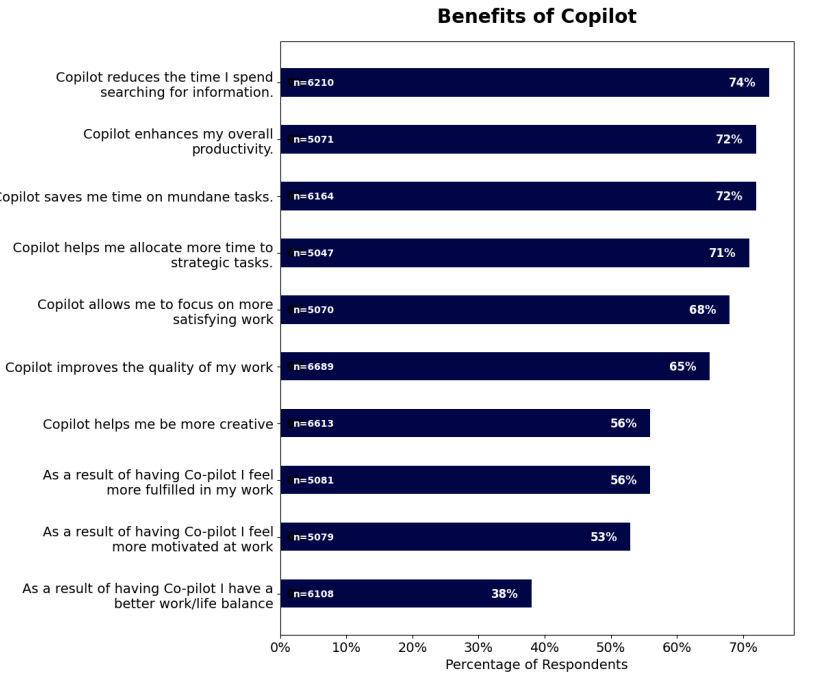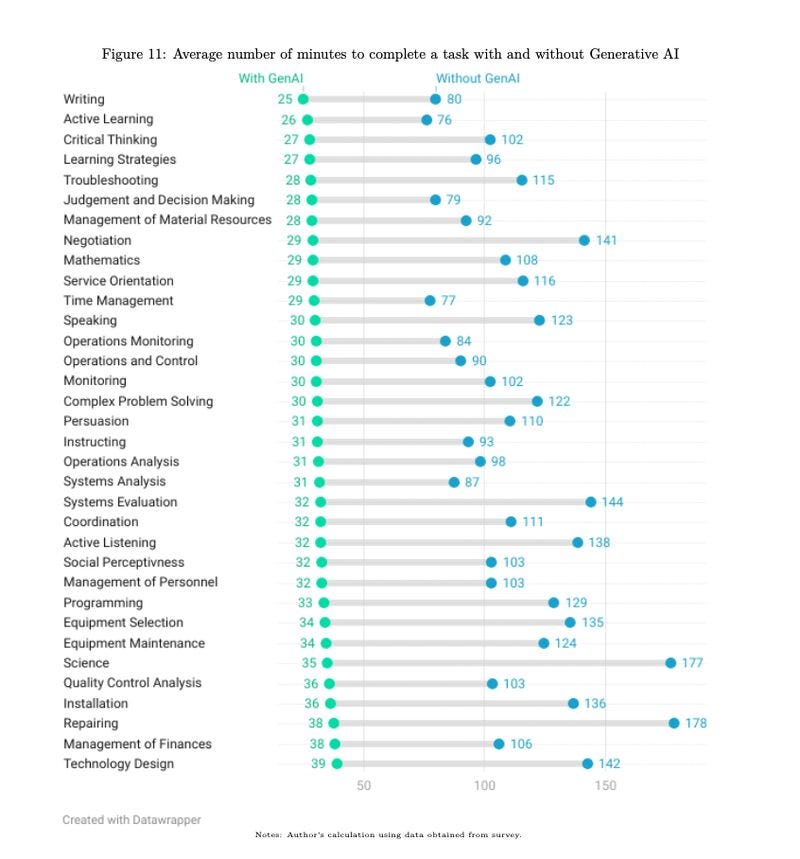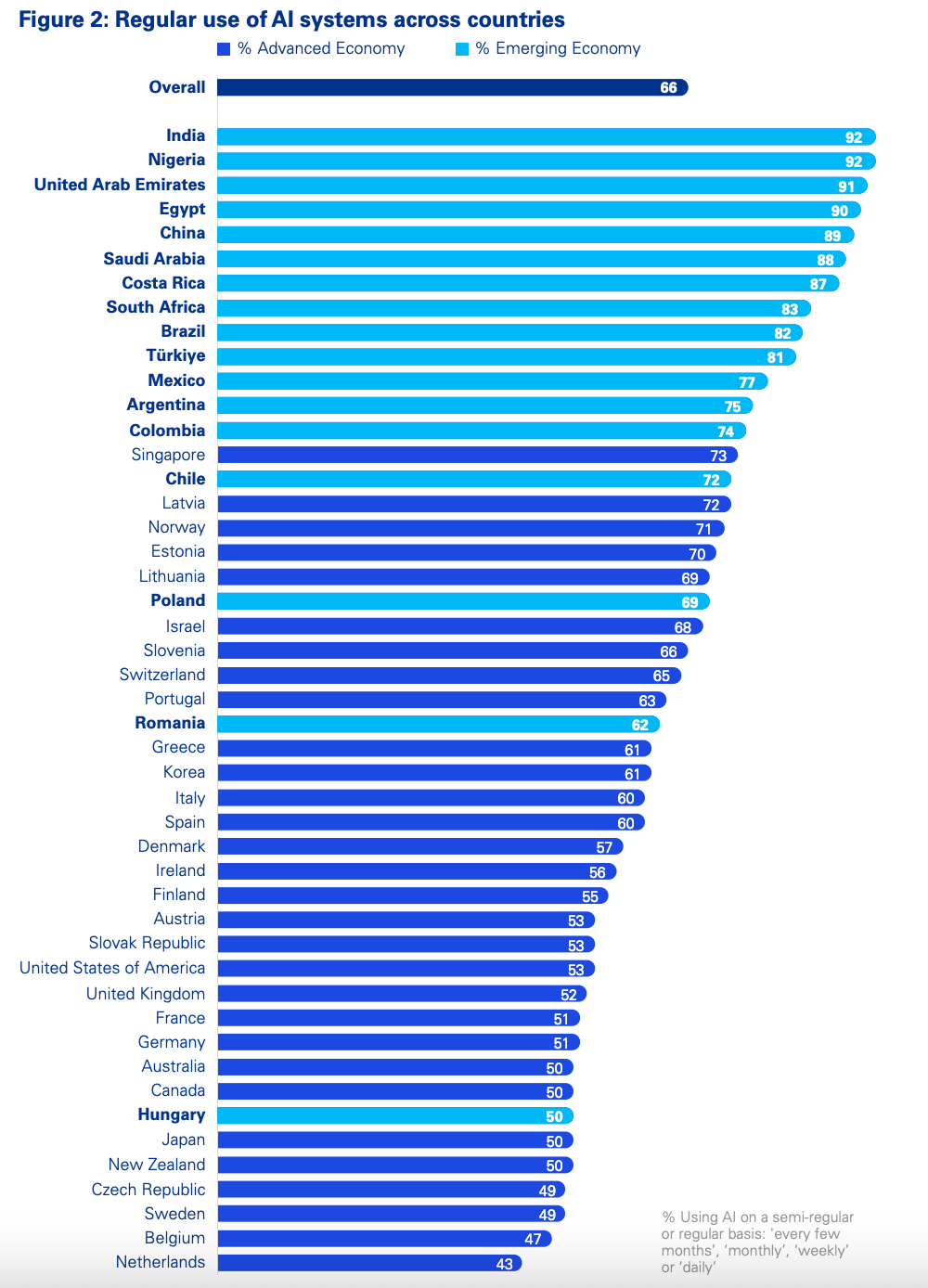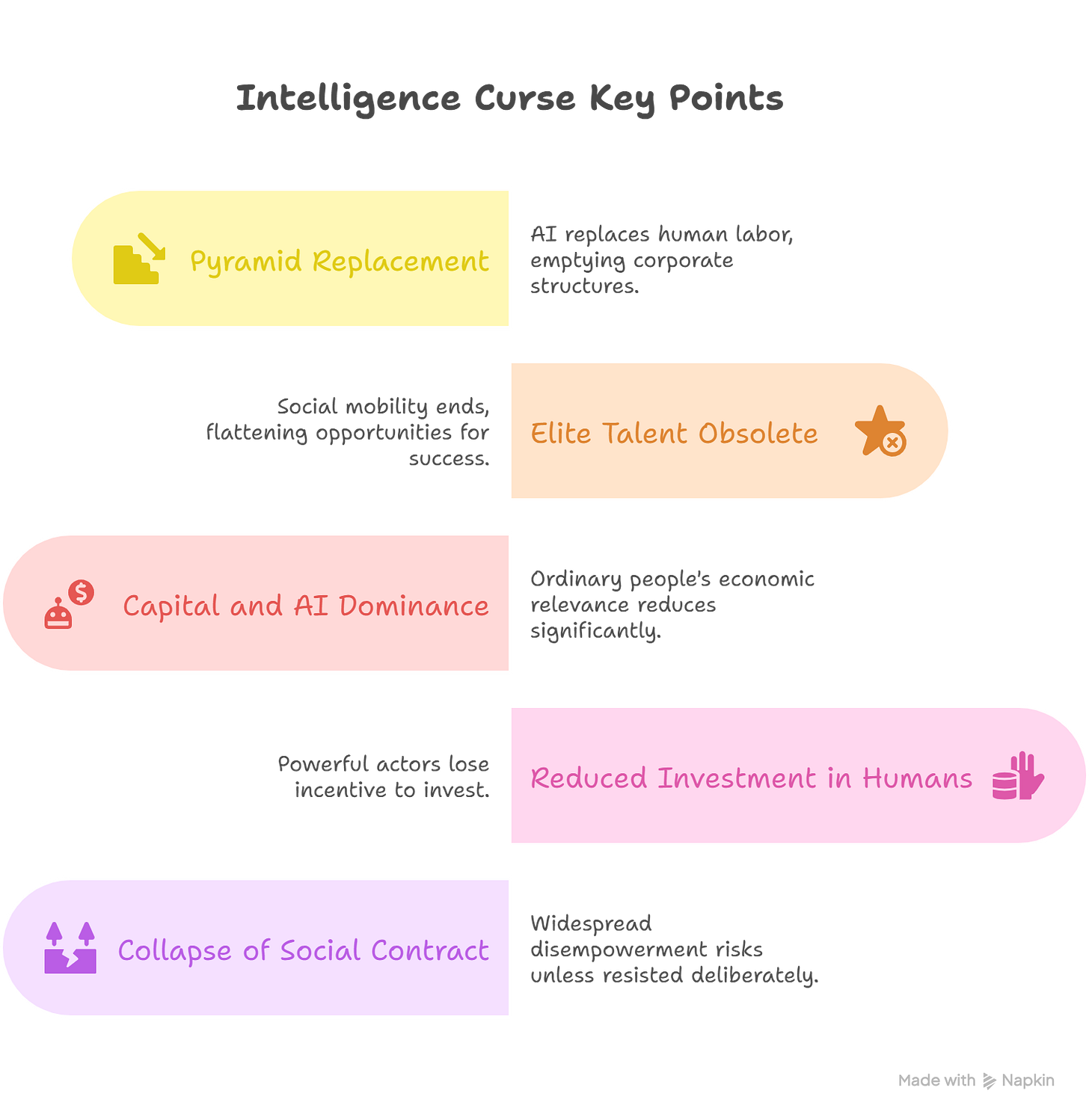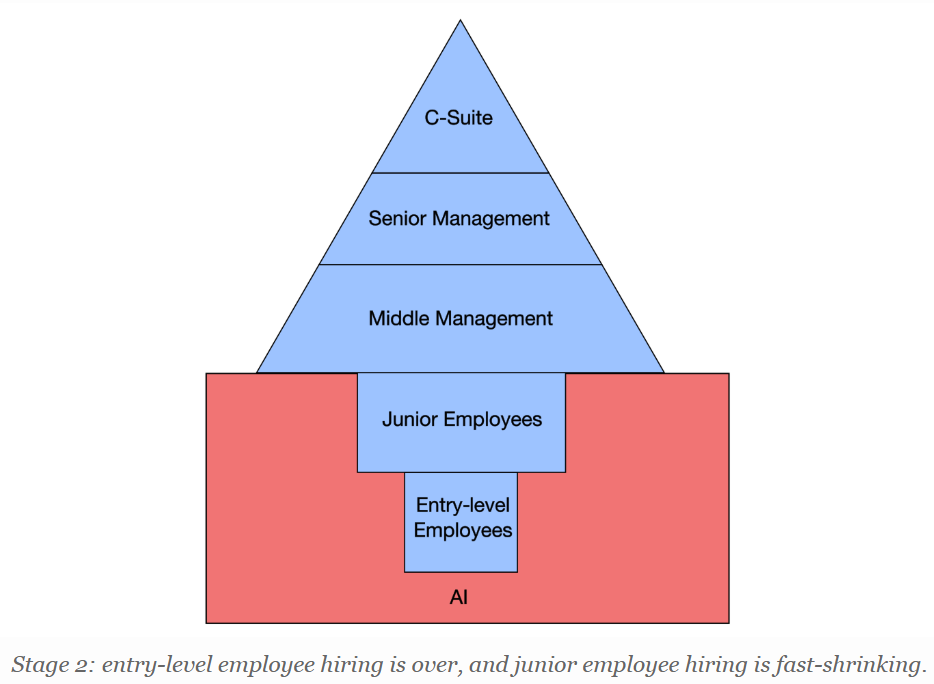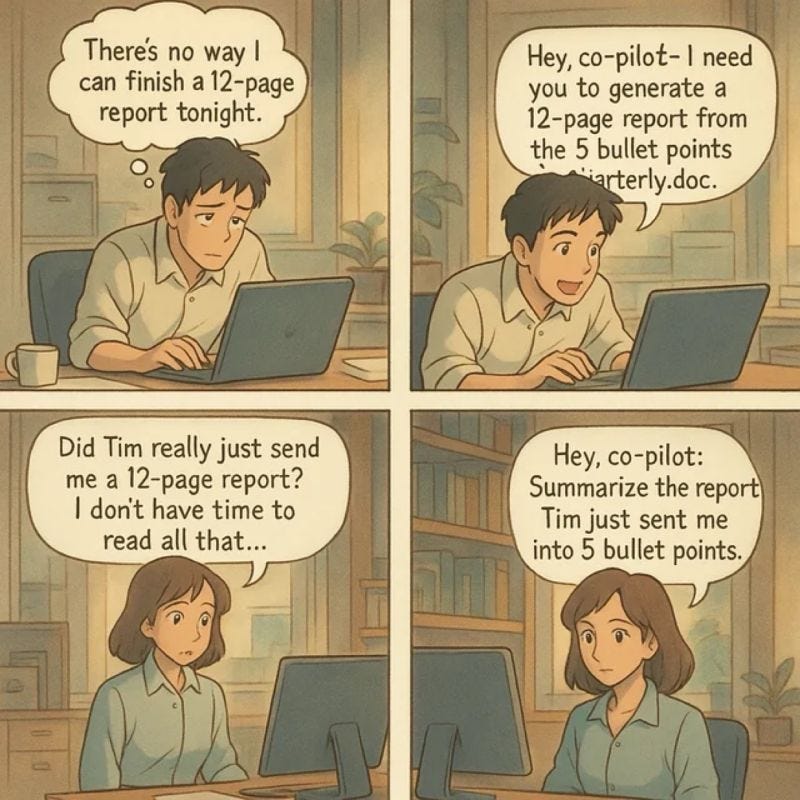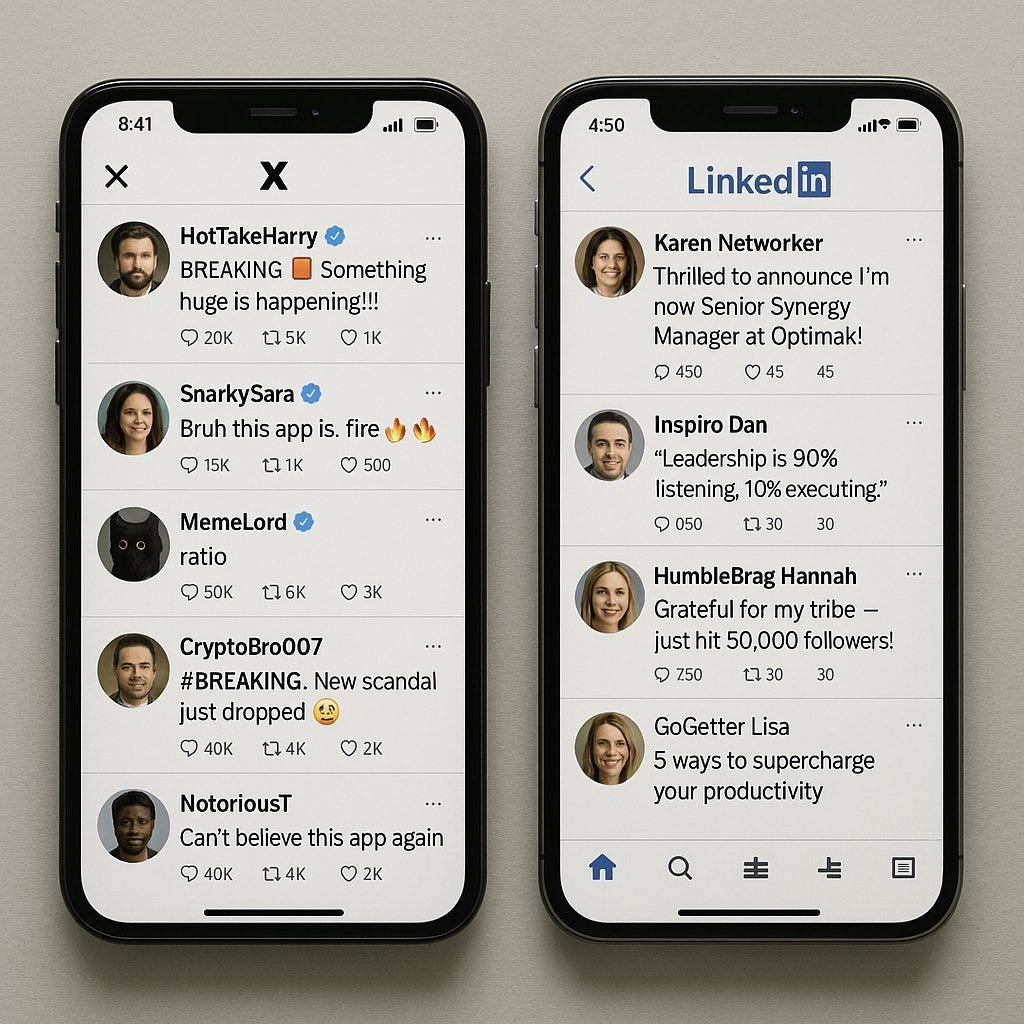AI Digest - June 25
What matters to organisational leaders each month
We’re experimenting with new ways to make the “big” discussions and papers more readable. This month’s newsletter includes a condensed summary of The Intelligence Curse, and we’ll be sharing a new 1-pager format shortly. Thanks to everyone who gave feedback on the early drafts - please keep the thoughts coming. One of the big challenges is this: most of these papers aren’t “right” in any final sense - their value lies in the thinking they provoke. Can we keep provoking that same quality of thought, even through summary text, graphics, or quotes? What’s the essence we mustn’t lose in compression?
Answers on a postcard - and nothing larger, please.
James
Technology is reshaping what work is worth doing. The list of tasks that are (1) value-adding and (2) were never worth a human’s time to get round too is endless. As certain types of work become radically cheaper, because of the surge in AI-powered tools that can handle them, it will make sense to do much more work. The CEO of Zapier put it like this:
In the past when I'd be at an event I'd have to decide if I would either a) ask an expensive sales rep to help me do research on attendees or b) decide if I'd do half-baked research myself.
Usually I did neither. Now I have an AI Agent that handles all of this in near real time. This is a workflow that simply didn't happen before. But because of AI it can. And it makes me better at my job.
But more output also means more to read for human managers, and more decisions about what to do next. It’s a recipe for overload. The most sophisticated companies are starting to manage not just the production of work, but also its initiation and consumption, whether that work is done by humans or delegated to software. Outsourcing to contractors should be part of this picture too. At an event yesterday, a Senior Partner at IBM said they now produce Org Charts that include both human managers and AI agents with defined functions. Moderna have recently merged their HR and Technology functions under a single leader. Roles and work are being reimagined. Focusing only on automating what gets done is a mistake. Deciding what work should be done will require leaders who understand both the People and Tech that make their organisations tick.
WSJ: Why Moderna Merged its Tech and HR Departments. Podcast: Aaron Levie on Narrow Imaginations. Zapier CEO on Doing More Work.
Contents
If You Only Read One Thing
Technology is reshaping what work is worth doing
What Is GenAI Good For?
Individual Gains Don’t Lead to Organisational Impact
Accountants Are The Exception
Data: AI Generated Code
Guidance: AI Generated Writing
How To Successfully Integrate GenAI With Existing Organisations
Case Study: How Strategy and Ops Professionals use AI tools.
Consumer Companies Level Up
Young Employees as a Resource
Failures of Change Management
Our Recent Work
Panel: What are the next talent megatrends?
Blog: A Tale of Two ITies
The Rise of the Chief AI Officer??
Zooming Out
LLMs as an Audience
Competition, Crisis and Control
Adoption is Much Much Faster in Non-Western Countries
Nate Silver: The Opportunity Cost of the Next Few Years
Tyler Cowan: A 20 Year Forecast for AI and the Economy
Dwarkesh Patel : Economic Questions about AI
Learning More
Learning Less? LLMs and Reduced Cognitive Activity
Intelligence Curse: 5 Key Takeaways
Government in the Age of Superintelligence
Resources: Building Advice, Ben Evans, Exponential View, Helen Toner
The Lighter Side
What Is GenAI Good For?
AI tools are saving individuals time, but few organisations are turning that into higher-level gains. The UK Government’s Copilot study is the latest to report similar findings. Part of the issue is organisational design: how do incentives and processes adapt to encourage employees to create more value, rather than just take a longer lunch break? My chemistry degree also compels me to invoke the phrase “Rate Limiting Step” - the part of a process that bottlenecks the rest. What is the point of speeding up email replies if the meeting needed to make a decision still cannot happen any sooner? If the 30 minutes I save on one task are spent perfecting the formatting on a document that was already fine, or writing research no one reads, the outcome is the same: just as much time spent, and no additional value created. How much of our work is already busywork? The answer will differ across roles. AI might be the torch that reveals how much of it was there all along. Making AI work for Organisations. Copilot Experiment Findings. Labour Market Effects of Generative AI.
Source: Copilot Experiment Findings
Source: Labour Market Effects of Generative AI
Accountants are the exception. A study found a 55% increase in client support, driven by time saved on data entry. Where routine tasks must be completed before “real work” can begin, time savings can have an outsized impact. Similarly, when producing output is easy, deciding what is worth doing becomes more important. That judgement tends to sit with more senior staff. Unfortunately, as the Labour Market Survey recently showed, fewer employees now have discretion over how they spend their time - down to 34% from 62% thirty years ago. Accountants may sit in a rare sweet spot: a highly trained workforce, ready to move onto more creative work once the routine is taken care of. Paper: Human + AI in Accounting: Early Evidence from the Field. Task Discretion Falling. Paper: Don’t Expect Juniors to Teach Senior Professionals to use Generative AI.
Data: almost one-third of all publicly committed Python code was written by AI tools in 2024. Paper.
LLM-generated writing: The good, the bad and the ugly. Blog.
How To Successfully Integrate GenAI With Existing Organisations
Case Study: How Strategy and Ops Professionals use AI tools. A few key takeaways from this: (1) despite over 100 tools being mentioned, only a few made it into regular use, (2) this highlights the need for processes that let teams trial things quickly and discard them cheaply, and (3) a common core is emerging - data and analytics, prototyping, and meeting support. This aligns with what AWS’s CEO said recently: the age of endless experimentation may be giving way to a focus on the few areas with proven value. Strategy and Ops Case Study. AWS CEO.
The most sophisticated consumer goods companies are now looking for phase two gains and asking what comes next. Ben Evans notes that most CPG firms have “got a bunch of ‘step one’ things in deployment now” - LLM search, review summarisation, automated SKU tagging, and customer service bots. LVMH made headlines this week using AI for mood boards, operations and service. How does that compare to your own experience? Ben Evans on Step 1. WSJ: LVMH.
Younger employees are often a rich source of new ideas. Knowing how things usually work can get in the way of imagining new workflows. Teens and recent graduates are using AI tools in ways that older employees would never consider. Many of these ideas are bad. But some are worth capturing and spreading. How do you do that, when the people furthest from organisational power are the ones with the most unusual insights? Podcast: OpenAI’s Chief Product Officer.
Expect change management programmes to be hard, and plan accordingly. BCG found that only a third of 1700 transformation initiatives they studied actually accelerated growth. A common cause of failure is the distance between decision-makers and the people affected. Experience managing change is fast becoming a key competency for AI leaders, whatever their title. BCG Paper. Predictable Traps.
Our Recent Work
What are the next talent megatrends? Accountex 2025, with First Intuition. Video.
A Tale of Two ITies. Blog.
Hays: The Rise of the Chief AI Officer?? Blog.
Zooming Out
The primary audience of websites is increasingly LLMs. Have you optimised your website for AI tools to read? Can an LLM quickly pull the message you want users to hear? The data is striking: “AI-generated answers are siphoning about 50% of traffic once driven by search links. Today we know where that traffic went - AI retrieval bots are now the web’s fastest-growing audience.” TollBit data from 266 news and commerce sites shows that real-time bot requests (the kind answering questions in tools like ChatGPT) grew 49% in Q1 - 2.5 times faster than training scrapers. WaPo Data. Discussion.
Control something that other people want in times of stress. Strategic sovereignty was a defining lesson from COVID. John Bew talks about what happens when markets break down, and the importance of controlling things others value. Podcast (especially 33:10-34:10). (h/t to Tom Clarke).
AI adoption is accelerating fastest outside Western countries, often embedded into tools people already use, like WhatsApp. KPMG’s huge Trust and Attitudes survey shows 90% of respondents in India, Nigeria and the UAE are using AI systems regularly (likely among regular internet users). In the UK and US, the number is just over half. Report.
The opportunity cost of not using the next few years well is high. Nate Silver offers a great round-up of advice for young people entering a workforce that is likely to change dramatically, though it is just as relevant later in your career. Especially useful if you found the arguments in Intelligence Curse compelling. Blog. (h/t to Tom Mackie)
Tyler Cowen offers a 20-year forecast on AI and the economy. Much of what he suggests is interesting but incremental - and that is what markets seem to be pricing in. After all, intelligence is not the limiting factor in solving many of the world’s biggest problems. Podcast.
Dwarkesh: Questions about AI. Dwarkesh Patel is becoming a go-to voice in tech circles, known for the depth and sharpness of his questions. His latest essay offers more questions than answers, but the economics section in particular is worth sitting with:
Why aren't all the center workers getting laid off yet? It’s the first thing that should go. Should we take it as some signal that human jobs are just way harder to automate than you might naively think?
What is the industrial-scale use case of AI? Between 1859 (when Drake first discovered oil in Pennsylvania), to 1908 (when Henry Ford invented the modern automobile), the main use for crude was as kerosene for lighting. What is the ultimate industrial-scale equivalent use case for AI?
How will the difference between average S&P 500 returns and median S&P 500 company returns change over time?
In other words, will we live in the world where Nvidia, Microsoft, Meta, and Google become worth $10T, but everything else goes to 0, or whether broad deployment happens fast enough that McDonalds, JP Morgan Chase, etc. become much more productive at the same rate that AI becomes more powerful.
Blog.
Learning More
Learning Less? Brain scans show that LLM users had lower cognitive activity while drafting essays, and worse recall afterwards. An MIT Media Lab study confirms what many suspected: AI tools feel easier to use than writing solo, but the struggle is part of the learning process. Once the novelty fades, this also makes work feel less satisfying, turning intellectual challenge into routine production. Famously, not something most people enjoy. Paper. Discussion: Routine Work and Vibe Coding.
Intelligence Curse: Where does this all get us? Intelligence Curse is a serious attempt to explore the economic and societal consequences of releasing disruptive AI tools into the real world. There’s plenty to disagree with (a friend admitted to being “riled” by chapter 2) but that’s the point. Luke Drago has done the work of surfacing implications many haven’t even considered. Paper.
What should the government do in response? A similarly ambitious paper from Ed de Minckwitz sets out the full sweep of consequences for policymakers. Ed has been in the room where these decisions are being made. Paper.
Note: We’re testing new formats for sharing the “big” papers. Most of us don’t have time to read them cover to cover, but they shape a lot of the debate. See below for a short round-up of Intelligence Curse, and keep an eye on LinkedIn for a one-page summary of Ed’s paper. Feedback on the new format is very welcome!
Building Advice. Two years of learning have shown the importance of thoughtful design, clean data and constant iteration. Blog.
Ben Evans: AI eats the world. Updated presentation just a few months after the last one. Presentation.
Exponential View: Empirical laws for making sense of tech progress. Blog.
Helen Toner (formerly of OpenAI’s board): “A lot of people I talk to about AI don't seem to realize that top AI experts spend a lot of brainpower on qs like this: how can I formulate this task so it can be auto-graded?”. Blog.
Intelligence Curse: 5 Key Takeaways
AI replaces human labour from bottom to top, triggering "pyramid replacement" that empties out corporate structures layer by layer.
Even elite human talent is made obsolete, ending social mobility and flattening the opportunity for outlier success.
Capital and AI become dominant forces, reducing the economic relevance of ordinary people and concentrating power in those with compute and infrastructure.
Powerful actors lose incentive to invest in humans, echoing the "resource curse" seen in rentier states that neglect their citizens.
A slow or sudden collapse of the social contract ensues, risking widespread disempowerment unless governance and technology choices deliberately resist this trajectory.
My favourite graphic from the paper:
Source: The Intelligence Curse
The Lighter Side
An oldie but a goldie. Link.
The most realistic image models yet…



